Missouri’s landscapes are under siege, from the skies to the streams. Invasive species are crowding out natives, wrecking crops, and spreading disease.
Some were brought here on purpose. Others hitchhiked in unnoticed. Now they’re everywhere- birds, bugs, beasts, and plants- all reshaping our forests, farms, and waterways in ways we can’t ignore.
Invasive Birds (Terrestrial)
European Starling (Sturnus vulgaris)
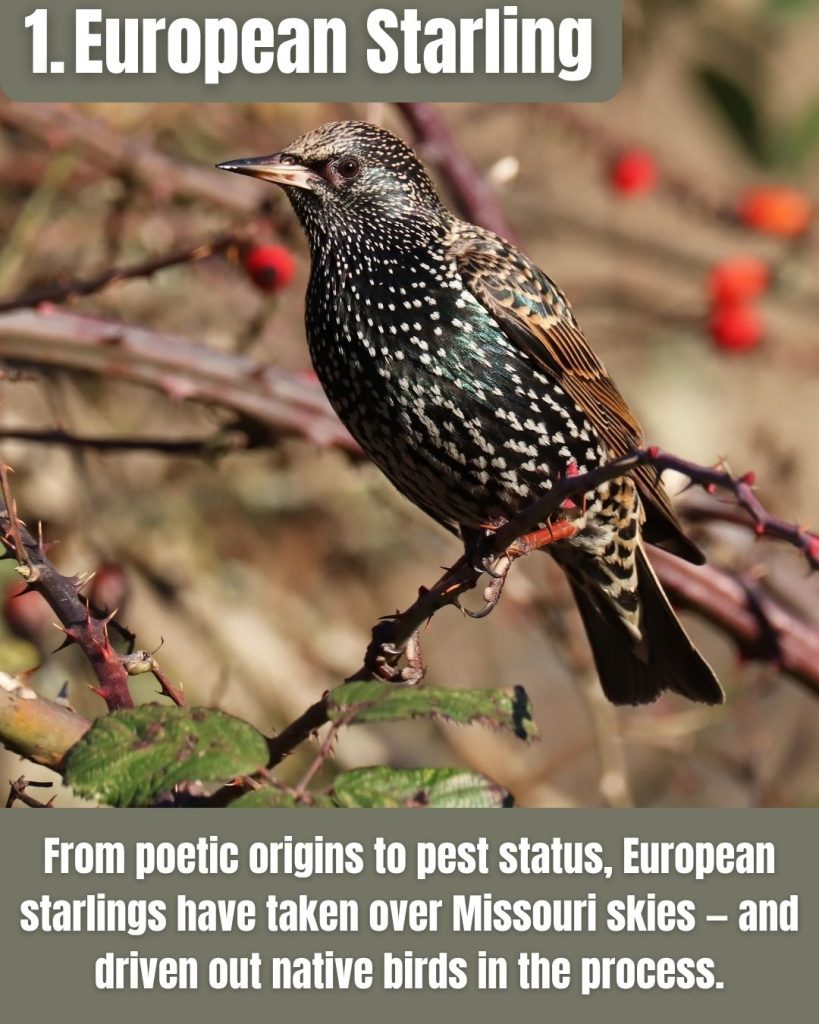
- Shakespeare’s mistake: Introduced in the 1890s by a group trying to release every bird mentioned by Shakespeare.
- Bird bullies: Take over nest cavities from native species like bluebirds and woodpeckers.
- Farm flock disasters: Gather in massive groups that destroy crops, contaminate livestock feed, and cause millions in ag losses.
Introduced in 1890 as part of a misguided plan to release every bird mentioned by Shakespeare, European starlings now number in the hundreds of millions across Missouri.
They seize nest cavities before bluebirds and woodpeckers can claim them, then descend in vast flocks that foul feedlots and cost U.S. agriculture an estimated $800 million a year by damaging grain and contaminating livestock feed.
House Sparrow (Passer domesticus)
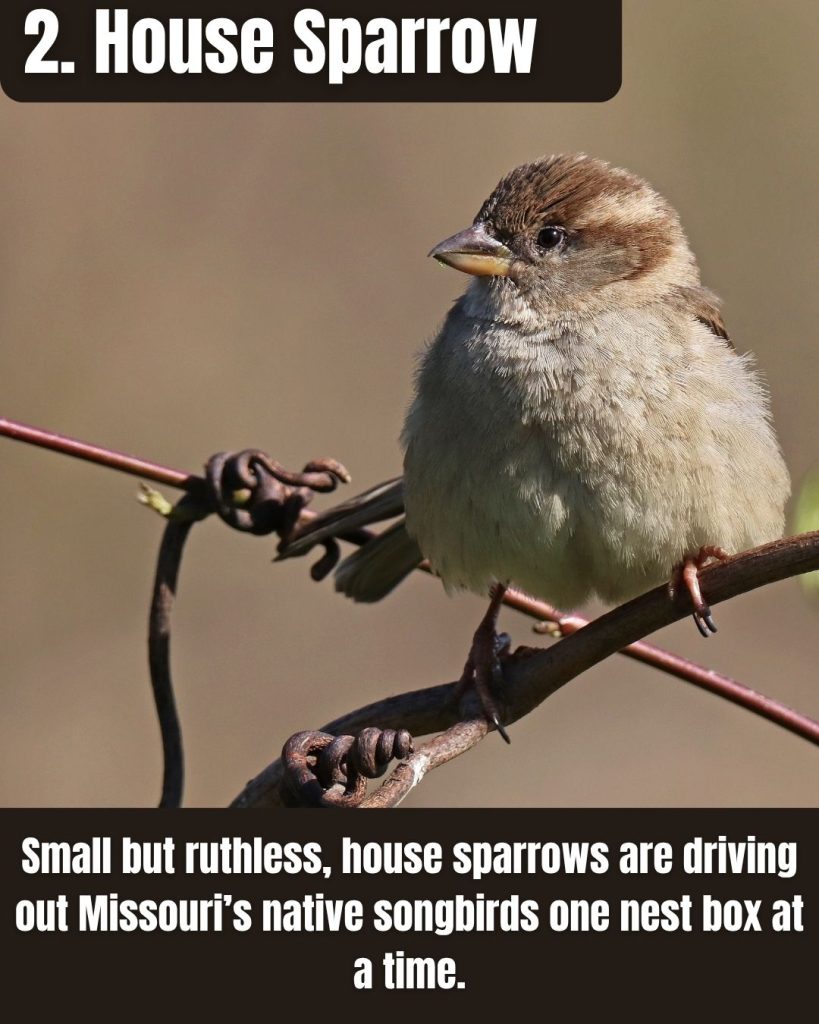
- Urban invaders: Thrive near people and buildings, now common across Missouri towns and farms.
- Aggressive squatters: Attack and evict native birds from nest boxes, sometimes killing them to take over.
- Reproduction machines: Raise multiple broods a year, quickly overwhelming native songbird populations.
Brought from Europe in the 1800s to eat urban insects (a job they barely perform), the plucky house sparrow has become one of Missouri’s most common birds.
Fiercely territorial, it drives native songbirds from nest boxes and happily pecks grain from silos, barns, and even livestock troughs, eaving contaminated feed and feathered skirmishes in its wake.
Rock Pigeon (Columba livia)
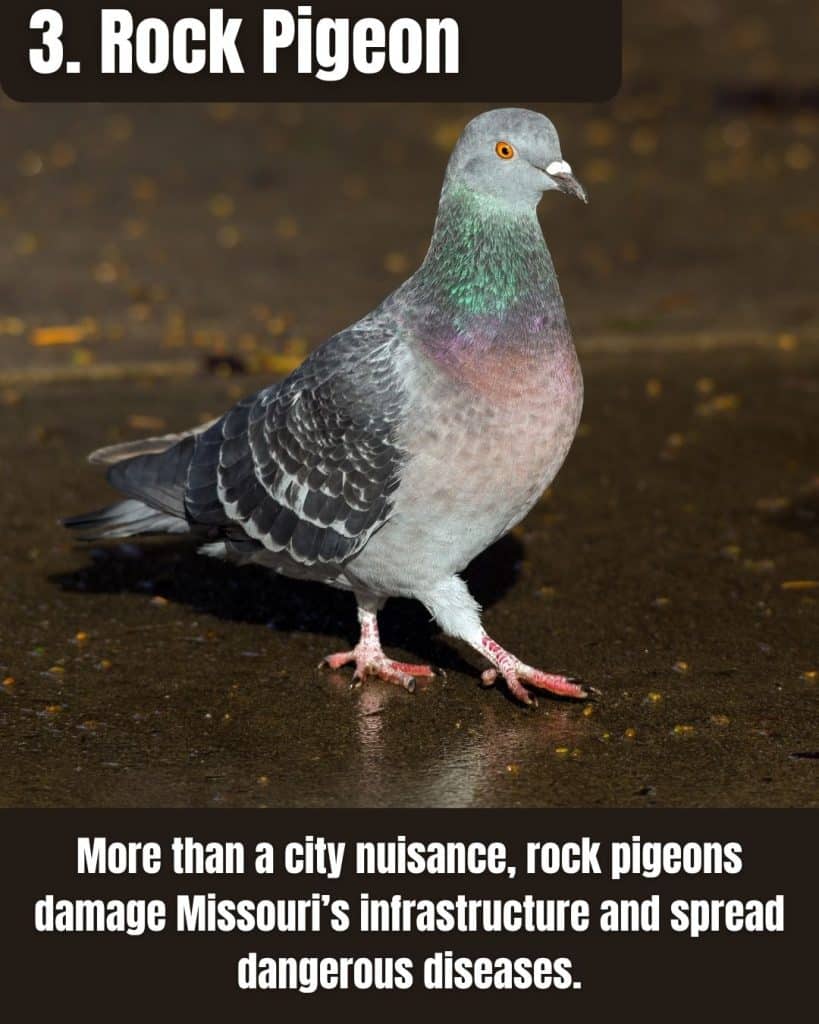
Descended from Old-World homing pigeons, the familiar city pigeon congregates on bridges, barns, and courthouse roofs.
Acidic droppings corrode stone and metal, while large flocks displace native doves and spread parasites that can also infect people.
A centuries-old introduction, pigeons remain a modern urban headache.
Eurasian Collared-Dove (Streptopelia decaocto)
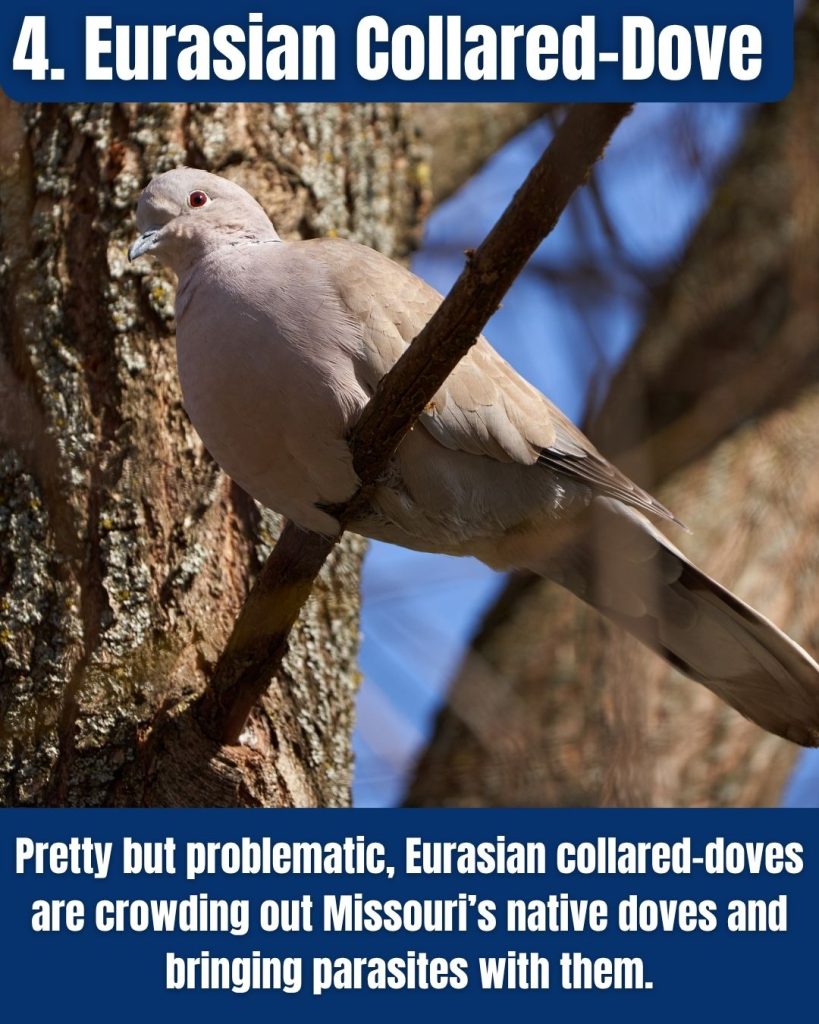
- Recent arrival, rapid spread: First showed up in Missouri in the 1990s and is now common in towns and farms.
- Native dove rival: Competes with mourning doves for food, feeders, and nesting spots.
- Disease carrier: Can transmit parasites like Trichomonas, threatening native doves and the hawks that eat them.
First released in the Bahamas in the 1970s, collared-doves reached Missouri by the late 1990s.
They breed almost year-round, crowding backyards and competing with mourning doves at feeders and nest sites.
Their tame demeanor around people, and their rapid population boom, explain why they now rank among the fastest-spreading invasive birds in North America.
Mute Swan (Cygnus olor)
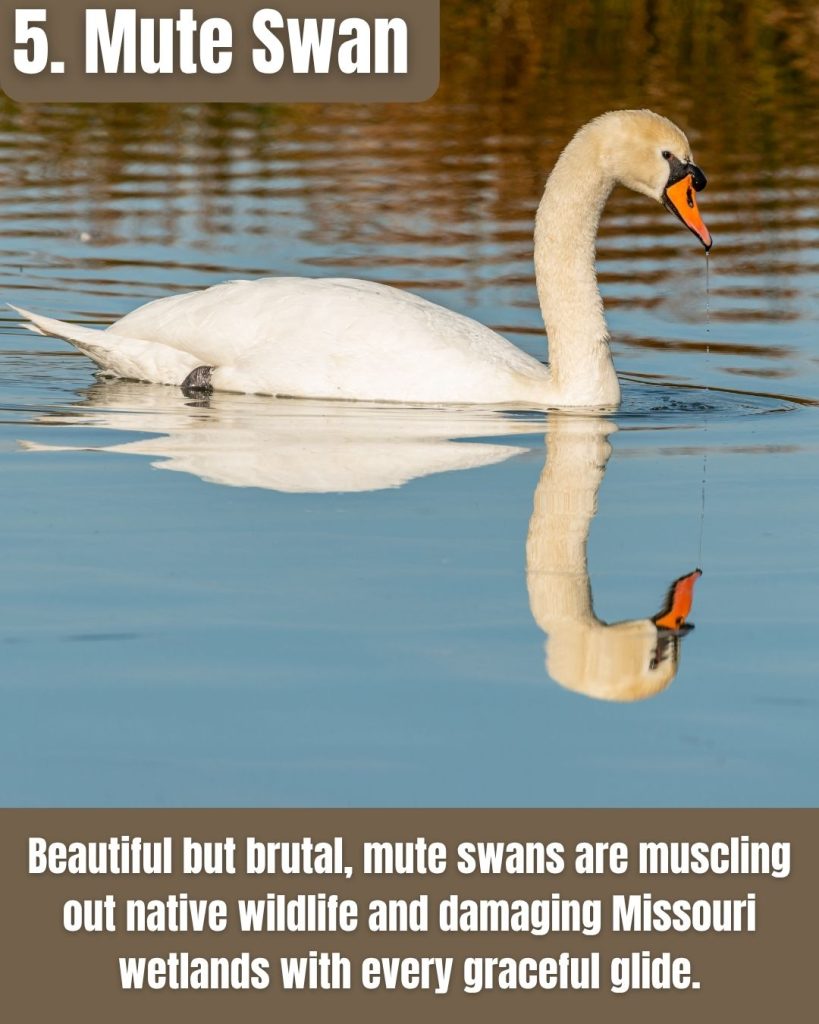
- Looks deceive: Elegant and quiet, but highly aggressive. They attack native waterfowl and even humans.
- Ecosystem wreckers: Tear up aquatic vegetation, destroying food and habitat for ducks, fish, and amphibians.
- Territorial takeover: Outcompete native trumpeter swans and geese, making conservation efforts more difficult.
Imported as ornamental park birds, mute swans are large, aggressive grazers that rip up aquatic vegetation and chase native ducks and geese off Missouri ponds.
One adult can eat eight pounds of plants daily, stripping shallow wetlands and turning rich marsh into open water.
Invasive Insects
Emerald Ash Borer (Agrilus planipennis)
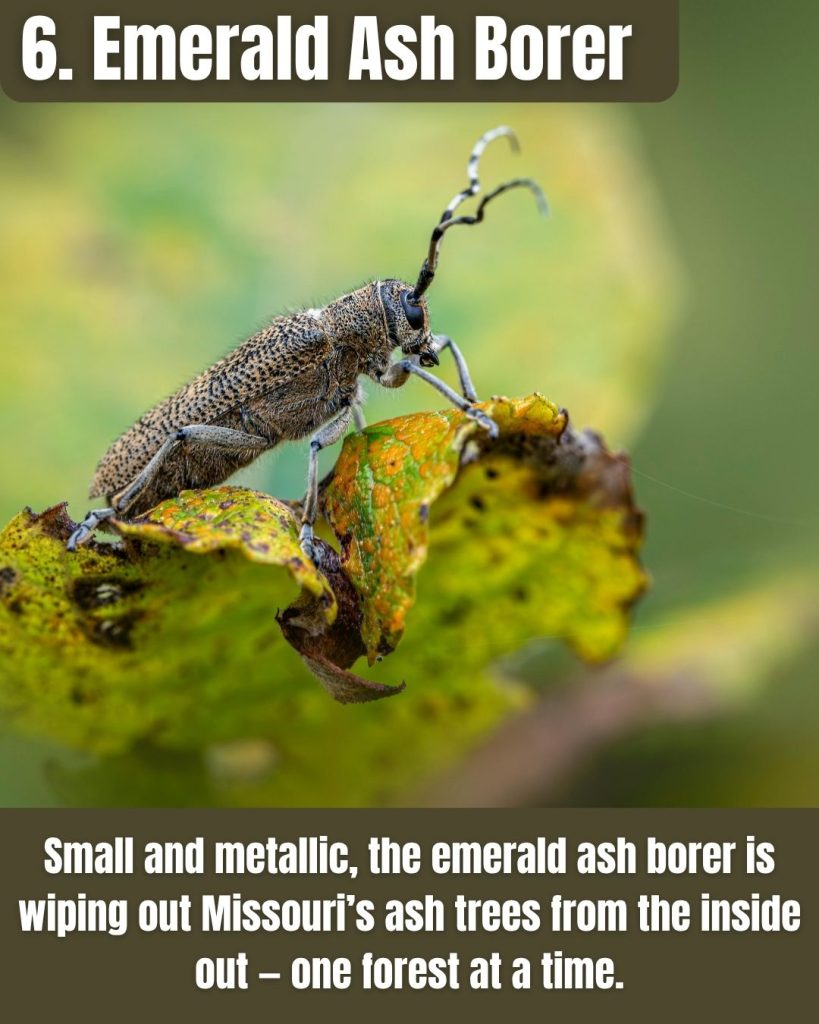
- Ash tree killer: Larvae tunnel under bark, cutting off nutrients and killing trees within 2–3 years.
- Widespread threat: Detected in Missouri in 2008 and now found in dozens of counties statewide.
- Irreplaceable loss: Endangers Missouri’s ash trees, which provide shade, lumber, and vital habitat for wildlife.
Metal-green and only half an inch long, the emerald ash borer has killed millions of ash trees since reaching Missouri in 2008.
Its larvae tunnel beneath bark, girdling trees that once shaded streets and forests; without intervention, foresters warn it could eliminate ash statewide.
Firewood quarantines and imported parasitic wasps are the main lines of defense.
Japanese Beetle (Popillia japonica)
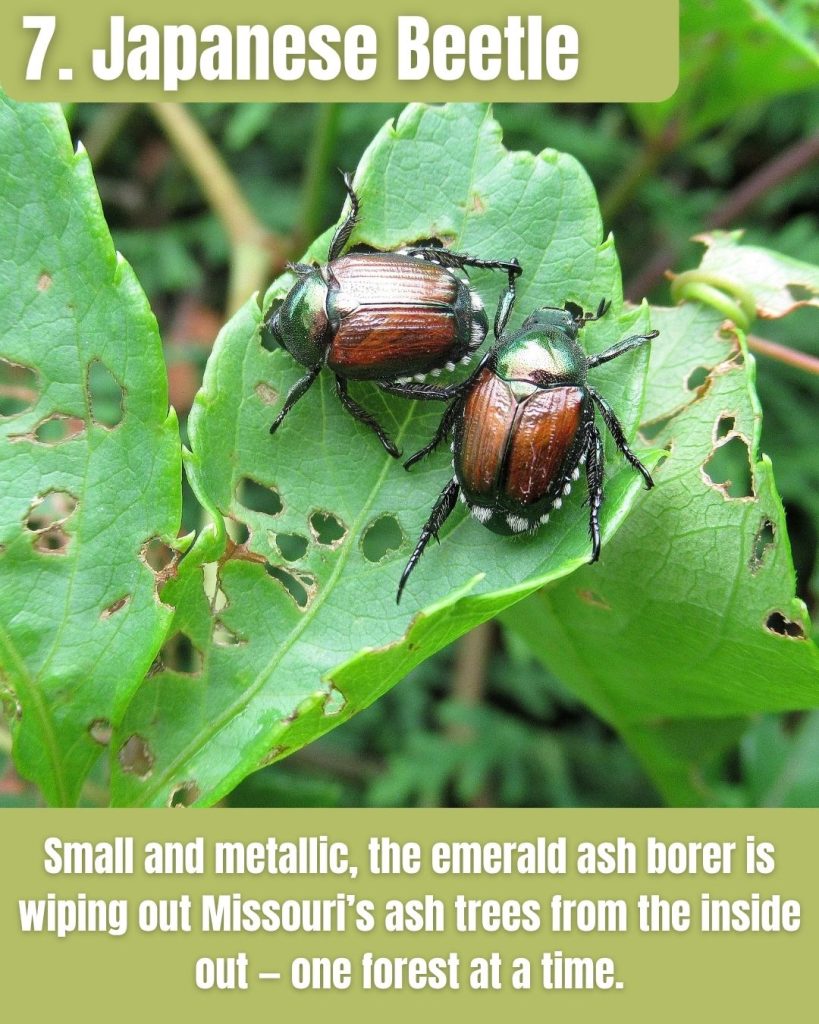
- Leaf skeletonizer: Adults chew through flowers, leaves, and fruit, leaving behind lacy, brown foliage.
- Lawn destroyer: Grubs feed on grass roots, turning lawns and pastures into dead, patchy messes.
- Hard to stop: Highly mobile and feeds on 300+ plant species, including roses, corn, soybeans, and grapes.
Since first appearing in St. Louis in 1932, this iridescent beetle has marched across Missouri. Adults gather in hordes to skeletonize roses, soybeans, grapes, and more, turning leaves into lace.
Populations boom every few summers, challenging gardeners and farmers who juggle traps, row covers, and timely insecticides.
Brown Marmorated Stink Bug (Halyomorpha halys)
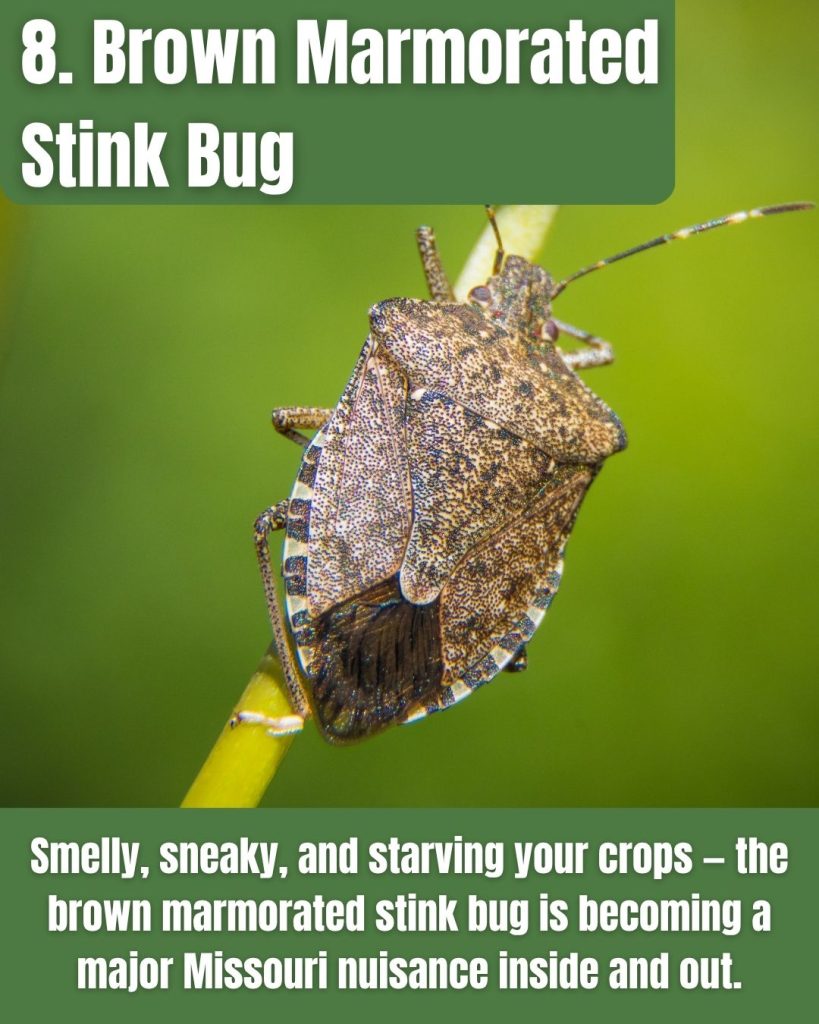
Confirmed in Missouri in 2013, the brown marmorated stink bug punctures fruit and vegetable skins, leaving corky scars that make produce unsellable.
Come autumn, thousands invade houses to overwinter, releasing their trademark odor when crushed, an unpleasant reminder of global trade’s stowaways.
Asian Tiger Mosquito (Aedes albopictus)
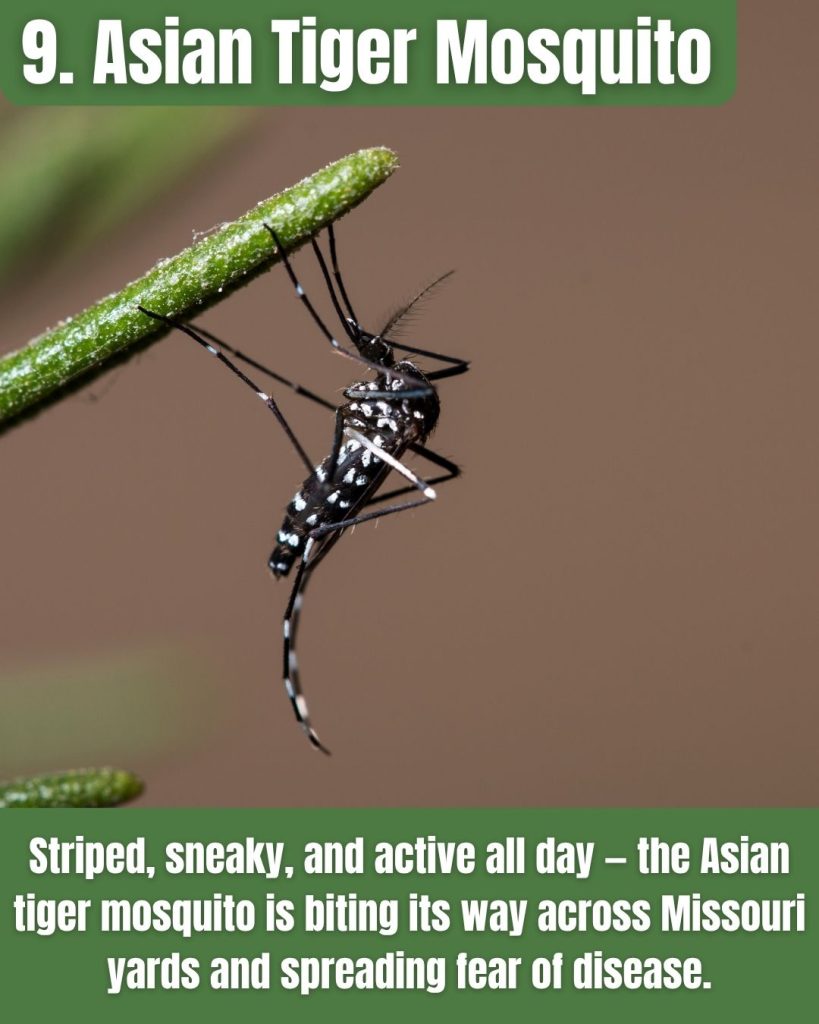
- Daytime biter: Unlike most mosquitoes, it’s active during the day, making outdoor time miserable even in sunlight.
- Disease risk: Can carry viruses like Zika, dengue, and West Nile, though transmission in Missouri is still rare.
- Fast breeder: Lays eggs in tiny amounts of standing water. Even a bottle cap can host larvae.
Hitchhiking to Missouri in used tire shipments during the 1980s, this day-biting mosquito now buzzes through backyards statewide.
Besides spoiling summer cookouts, it carries West Nile, dengue, and chikungunya viruses and breeds in small containers, from flowerpot saucers to forgotten gutters.
Spotted Lanternfly (Lycorma delicatula)
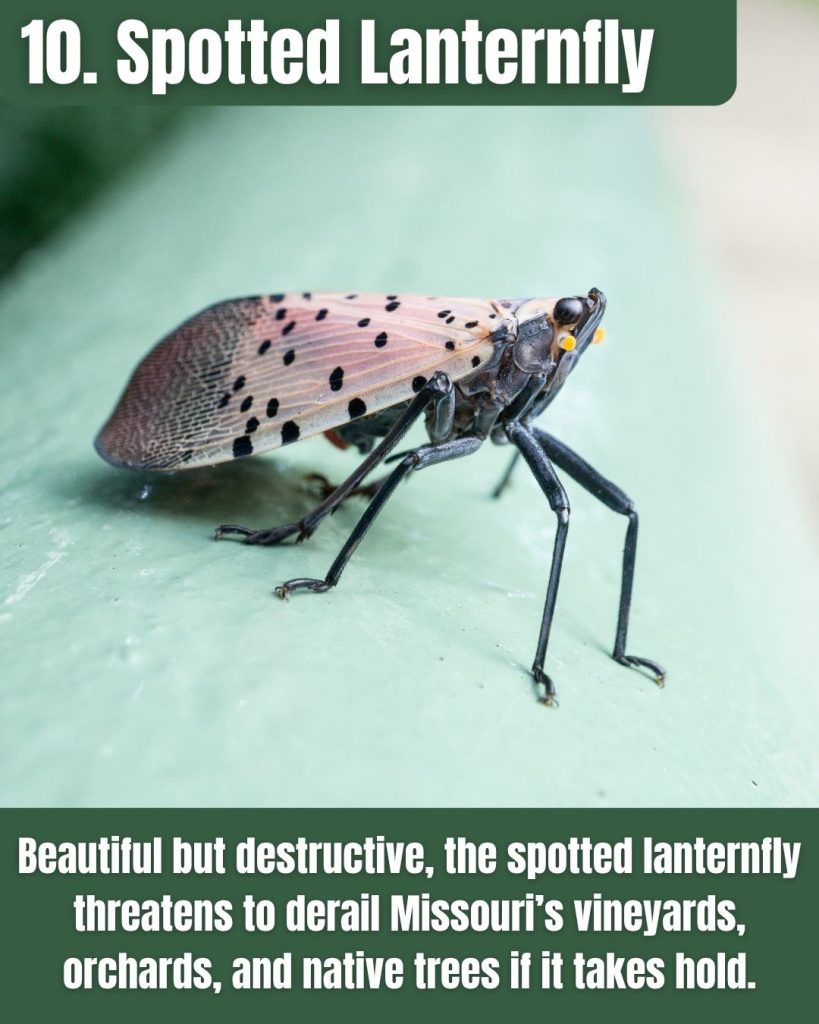
- New but dangerous: Not yet widespread in Missouri, but closely watched due to its devastating impact on vineyards and orchards.
- Sap suckers: Feed on over 70 plant species, weakening trees and crops while leaving behind sticky “honeydew” that grows mold.
- Hitchhiker pest: Eggs are laid on vehicles, firewood, and trailers, making unintentional spread across the state a serious risk.
Not yet established, but officials urge vigilance: in states farther east, lanternflies swarm vineyards, orchards, and maples, excreting sticky honeydew that fosters sooty mold.
Egg masses on vehicles or outdoor gear could spark Missouri’s first infestation, so early reporting is critical.
Invasive Animals (Non-Bird, Non-Insect)
Feral Hog (Sus scrofa)
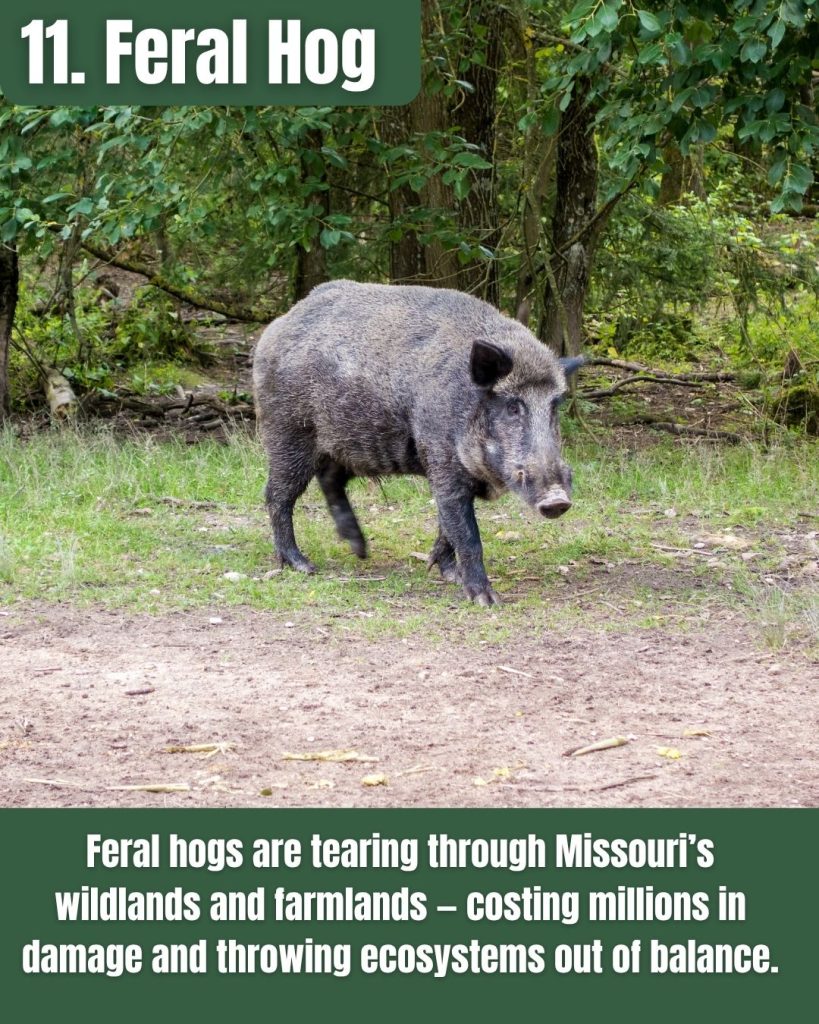
- Rooting wreckers: Tear up forests, fields, and wetlands, causing erosion, destroying crops, and damaging wildlife habitat.
- Exploding population: Reproduces rapidly. A single sow can produce two litters per year, with up to a dozen piglets.
- Disease risk: Carry harmful diseases like brucellosis and pseudorabies, threatening livestock and native wildlife.
With sows raising multiple litters a year, feral hogs tear up crops, pastures, and forests, rooting like rototillers and muddying streams.
Missouri’s eradication crews trap entire “sounders,” because scattering them only spreads the problem, and the diseases hogs can pass to livestock and wildlife.
Feral Cat (Felis catus)
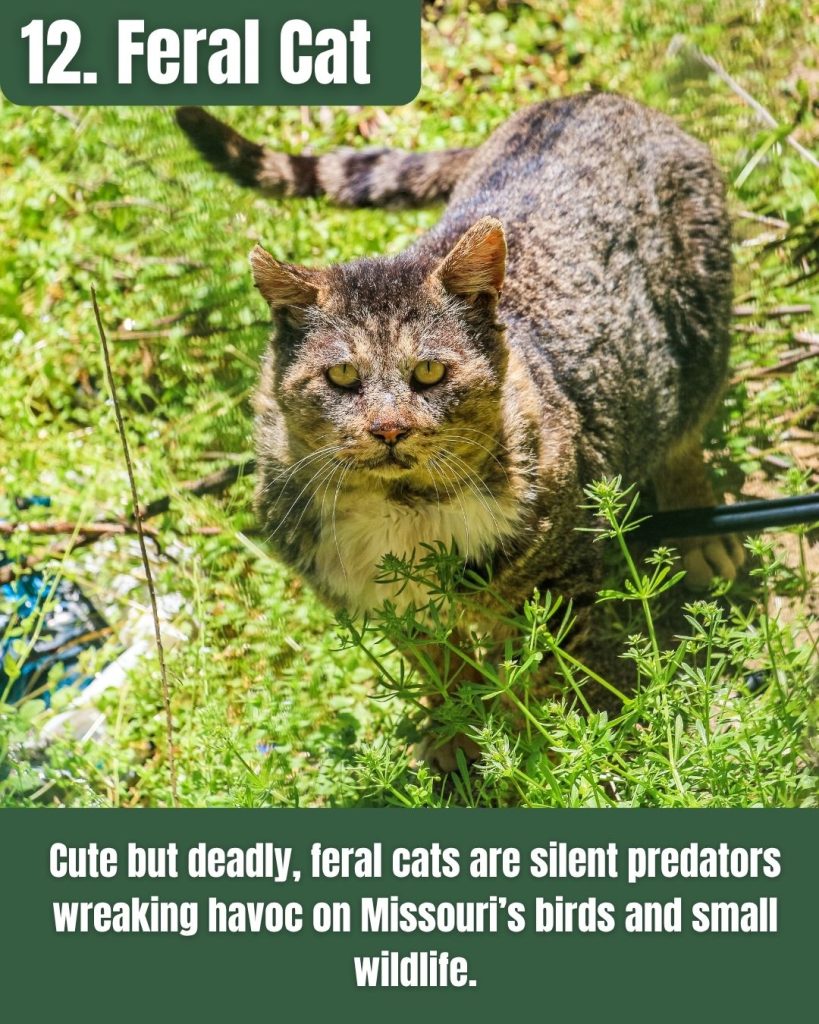
- Efficient predators: Kill billions of birds, reptiles, and small mammals annually, many of them native and declining species.
- Hard to manage: Reproduce quickly and often avoid traps, making control efforts difficult in both rural and urban areas.
- Wildlife threat: Considered one of the top invasive species worldwide, they pose a serious risk to Missouri’s native biodiversity.
Whether abandoned pets or generations-old barn cats, outdoor cats kill an estimated 2.4 billion birds annually in the U.S. Missouri’s songbirds, small mammals, and herpetofauna all feel the toll.
Conservationists urge cat owners to keep pets indoors or build “catios” to protect both wildlife and the cats themselves.
Nutria (Myocastor coypus)
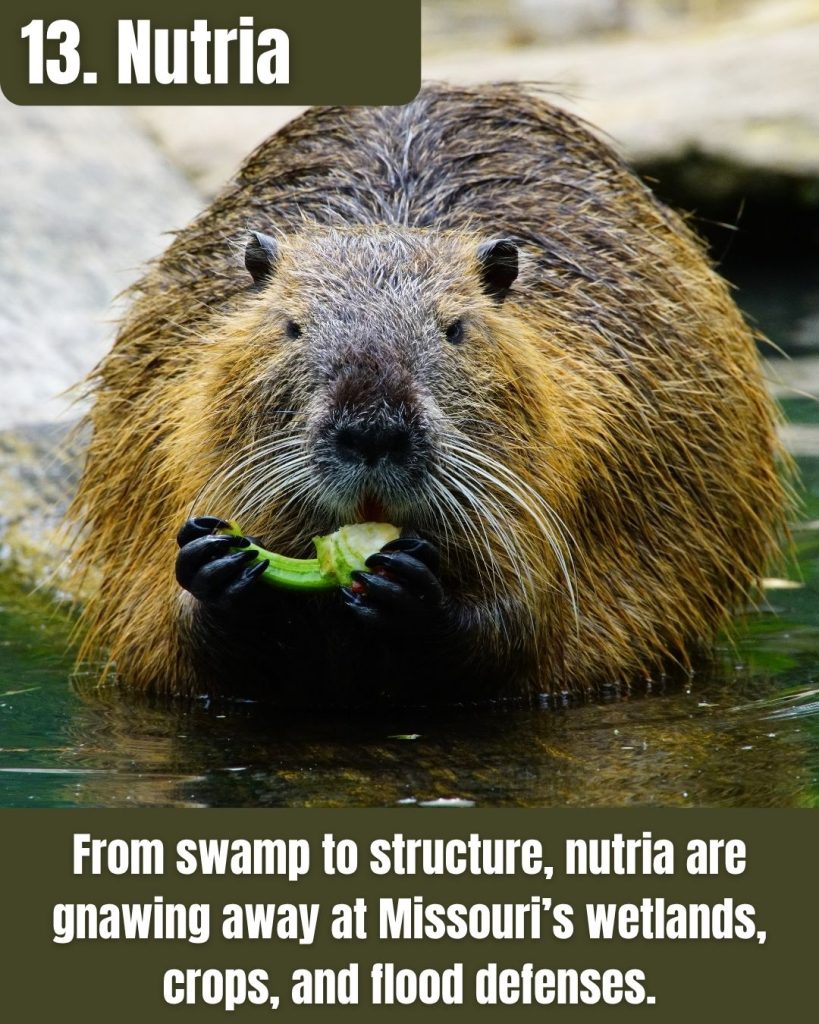
Escaped South American fur-farm rodents now gnaw southeastern Missouri marshes.
Each 20-pound nutria consumes a quarter of its weight in vegetation daily, turning lush wetlands into open water and weakening levees with burrows.
Cold winters limit their spread, but mild seasons can spark local population blooms.
Norway Rat (Rattus norvegicus)
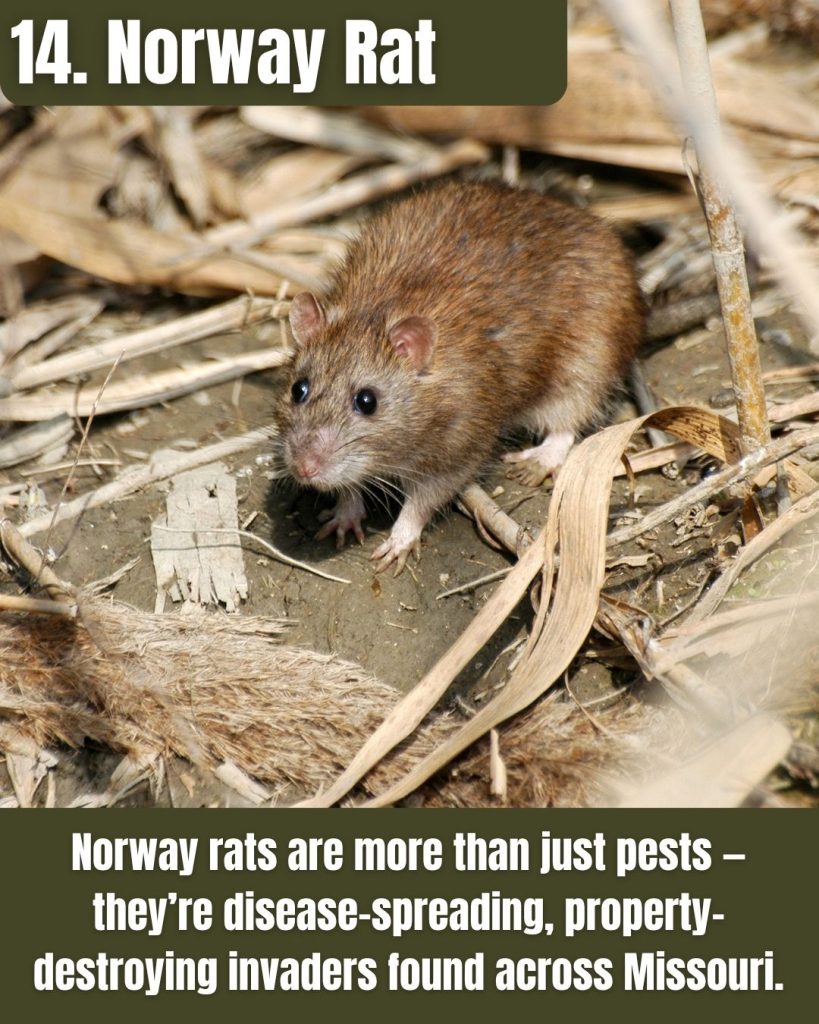
- City survivors: Thrive in urban Missouri, from alleyways to barns, chewing through wood, wires, and walls.
- Public health threat: Spread dangerous diseases like salmonella, typhus, and rat-bite fever.
- Livestock menace: Invade poultry houses, eat grain, and have even been known to attack young chicks and piglets.
A stowaway since colonial times, the brown rat infests grain elevators, restaurants, and sewers. It chews wiring and wood, contaminates food, and spreads diseases such as leptospirosis and salmonellosis.
Rats also raid ground-nesting bird eggs, adding ecological injury to urban insult.
House Mouse (Mus musculus)
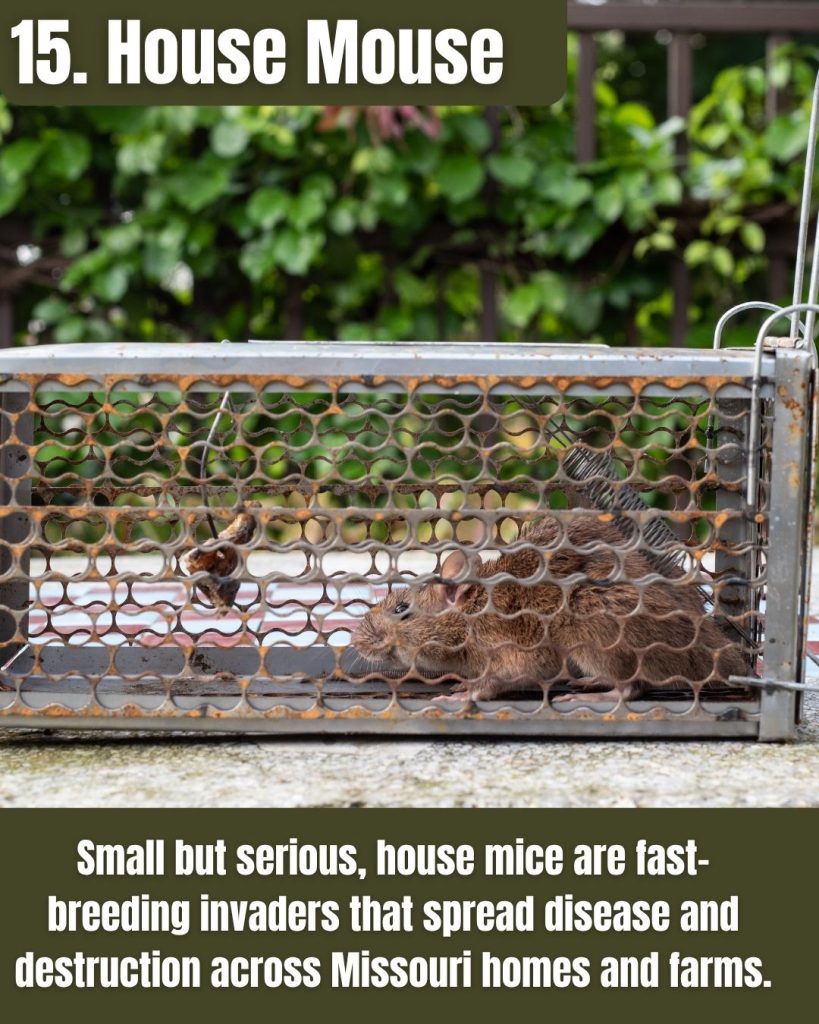
- Tiny invaders: Squeeze through openings as small as a dime to infest homes, barns, and businesses across Missouri.
- Rapid reproducers: One pair can produce dozens of offspring in a matter of months, quickly overwhelming a space.
- Health hazard: Contaminate food and surfaces with droppings and urine, spreading diseases like salmonella and hantavirus.
Small but prolific, house mice slip through quarter-inch gaps, shred insulation, and spoil pantry goods with droppings that can carry hantavirus.
Outdoors, high mouse numbers fuel predator booms that may subsequently pressure native prey species… A ripple effect from a creature that weighs barely half an ounce.
Invasive Terrestrial Plants
Bush Honeysuckle (Lonicera spp.)

- Early to rise, late to fade: Leaf out earlier and stay green longer than native plants, stealing sunlight and space.
- Wildlife disruptor: Creates dense thickets that crowd out native understory plants and provide poor habitat and nutrition for wildlife.
- Rapid spreader: Birds eat the berries and spread seeds far and wide, helping honeysuckle take over forests, parks, and fencerows.
Leafing out before Missouri’s spring ephemerals, bush honeysuckle forms dense, shady thickets that starve native wildflowers of light.
Birds spread its nutrient-poor red berries, and the shrub may release soil toxins that further suppress competitors, leaving woodlands quieter and less diverse.
[I’ve been battling these things for YEARS]
Callery (Bradford) Pear (Pyrus calleryana)
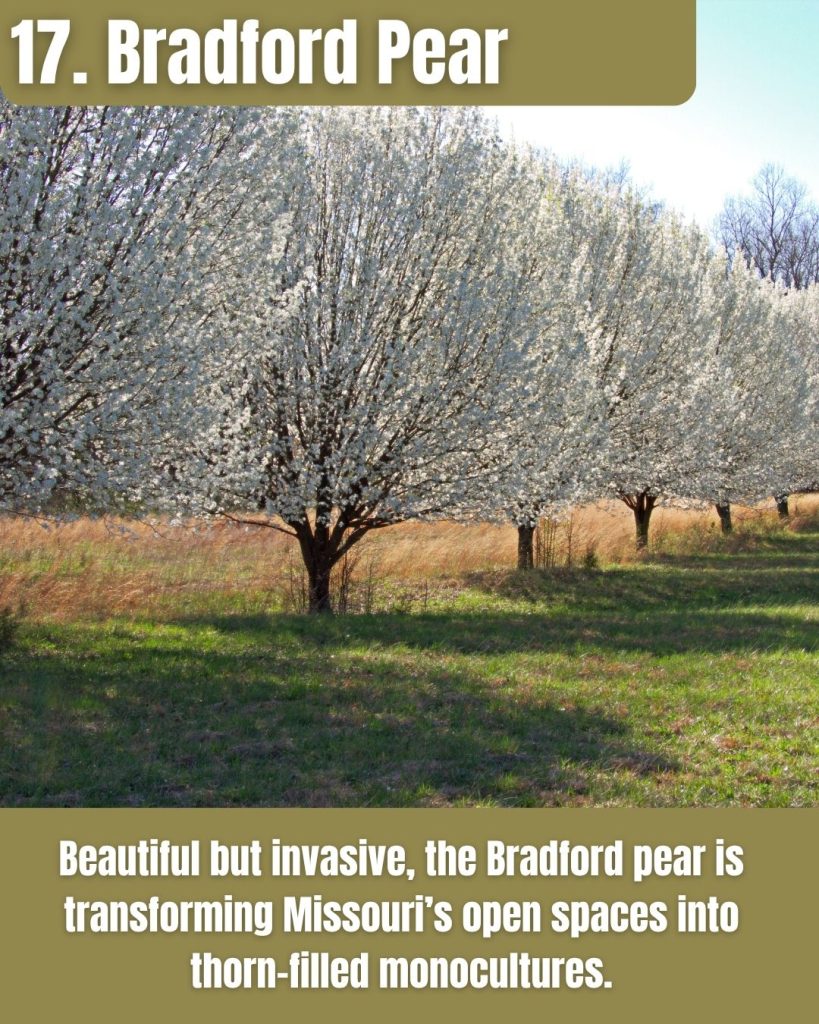
- From ornamental to outlaw: Once beloved for its blooms, now banned in Missouri due to its aggressive spread.
- Thorny takeover: Crossbreeds easily and escapes landscaping, forming dense, thorny thickets in fields and forests.
- Ecological dead zone: Offers little food or shelter for wildlife and crowds out native trees and plants.
Once a suburban darling, this ornamental pear escaped plantings to line roadsides with a froth of white blooms each April.
Cross-pollinated cultivars now produce fertile fruit that birds disperse, creating thorny thickets that crowd out prairie grasses and young oaks. Missouri banned its sale in 2025.
Autumn Olive (Elaeagnus umbellata)
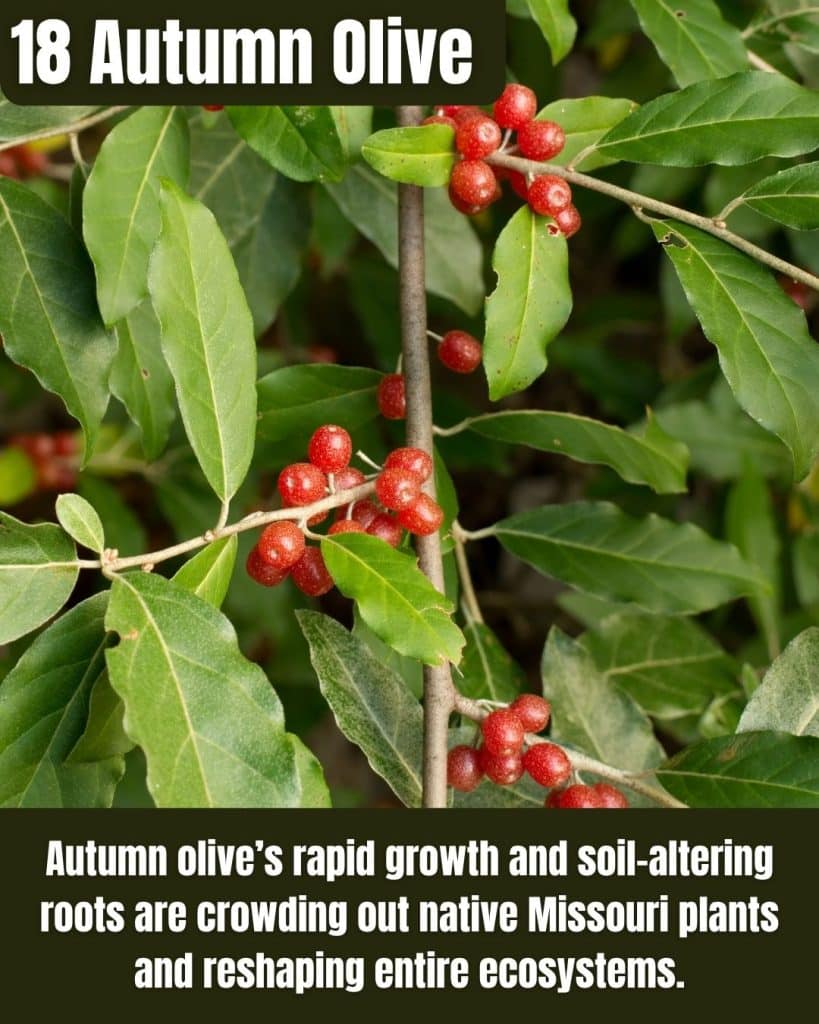
- Unwanted comeback story: Introduced for erosion control and wildlife cover, now a top invader in Missouri fields and roadsides.
- Soil changer: Fixes nitrogen, which alters soil chemistry and gives it an edge over native plants.
- Berry boom: Produces thousands of red berries eaten by birds, spreading it rapidly across the landscape.
Planted for erosion control, autumn olive thrives on poor soils by fixing nitrogen, then overshadows native prairie plants. Stands alter soil chemistry and can even favor mosquito breeding.
Each shrub yields thousands of berries, all too eagerly distributed by songbirds.
Sericea Lespedeza (Lespedeza cuneata)
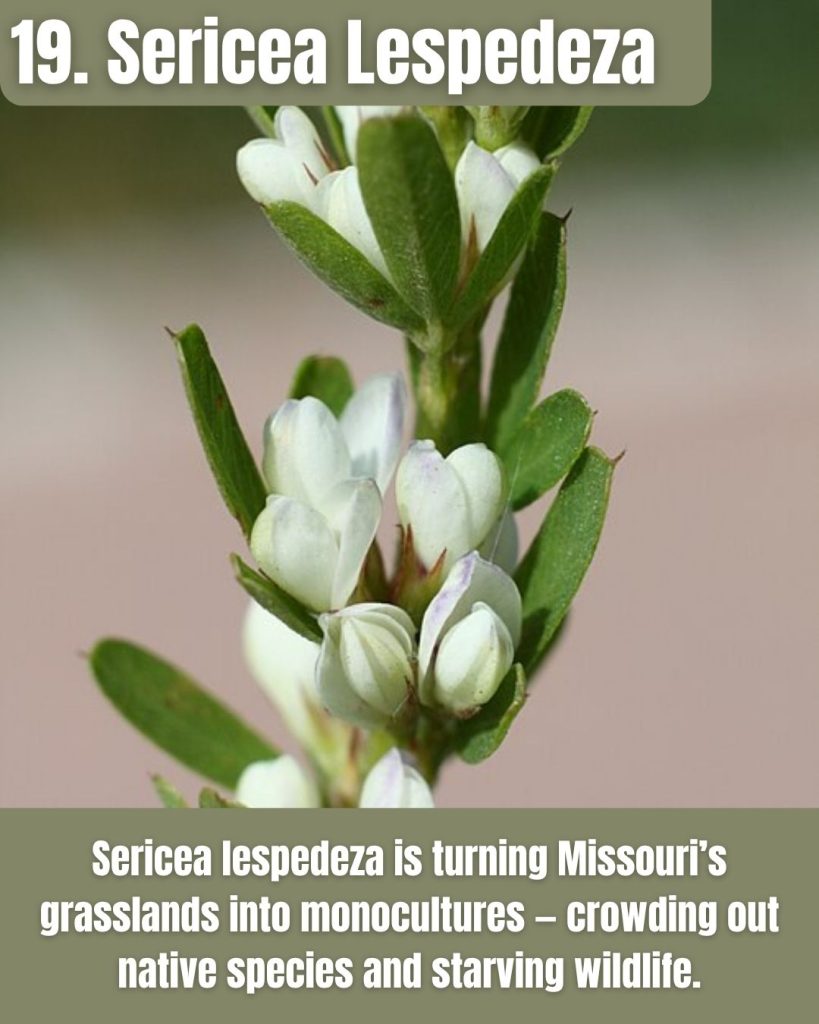
- Range invader: Introduced for erosion control and forage, but quickly overtakes prairies, glades, and pastures.
- Wildlife unfriendly: High tannin levels make it unpalatable to most wildlife and livestock, reducing habitat quality.
- Seed factory: Produces thousands of seeds that can remain viable in the soil for over 20 years.
This drought-tough legume dominates over-grazed fields, its tannin-rich leaves unpalatable to deer and cattle.
Deep taproots and a seed bank viable for two decades make control difficult; repeated herbicide treatments plus prescribed burns are the usual prescription.
Garlic Mustard (Alliaria petiolata)
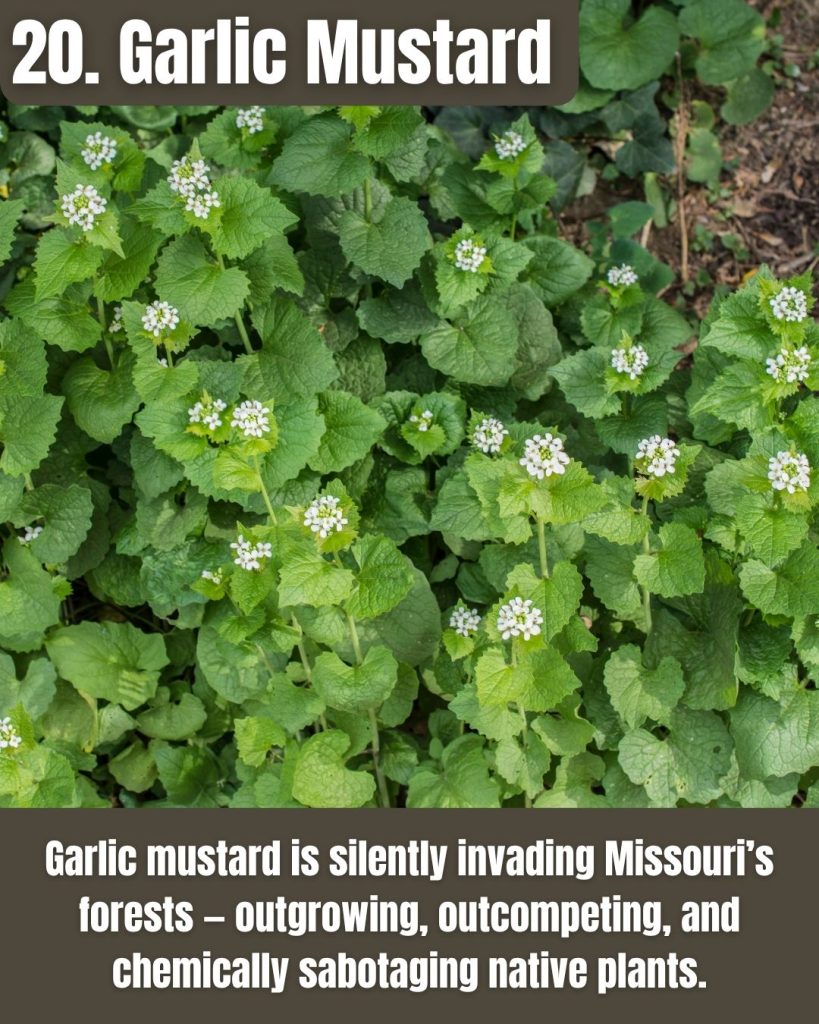
- Early starter, fierce competitor: Sprouts in late winter and shades out native wildflowers before they can grow.
- Chemical warfare: Releases compounds into the soil that inhibit native plant and fungi growth.
- Explosive spread: One plant can produce hundreds of seeds, allowing it to take over forest floors rapidly.
Early-sprouting rosettes of garlic-scented leaves carpet shaded slopes, outcompeting spring wildflowers and poisoning soil fungi that native trees need.
One plant releases thousands of seeds, so annual “pull-and-pesto” events remain the best community defense.
Invasive Aquatic Species (Fish & Water Plants)
Silver Carp (Hypophthalmichthys molitrix)
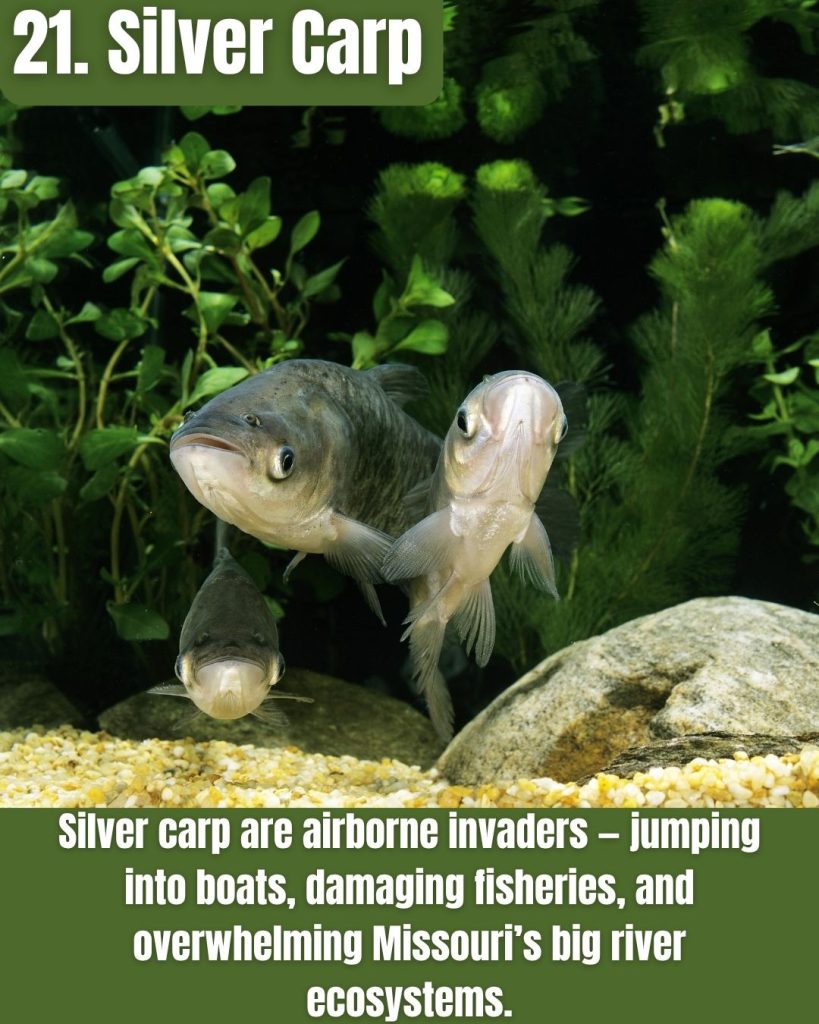
- Jump scare: Known for leaping up to 10 feet out of the water when startled, injuring boaters and disrupting recreation.
- Plankton pirates: Filter feeders that consume massive amounts of plankton, robbing native fish and mussels of food.
- River invaders: Now dominate sections of the Missouri and Mississippi Rivers, outcompeting native fish for space and resources.
Filter-feeding Asian carp dominate plankton in the Missouri and Mississippi Rivers, starving paddlefish and young sportfish.
Alarmingly, startled adults can rocket ten feet into the air, injuring boaters and breaking gear, a biological and recreational nightmare.
Bighead Carp (Hypopht halmichthys nobilis)
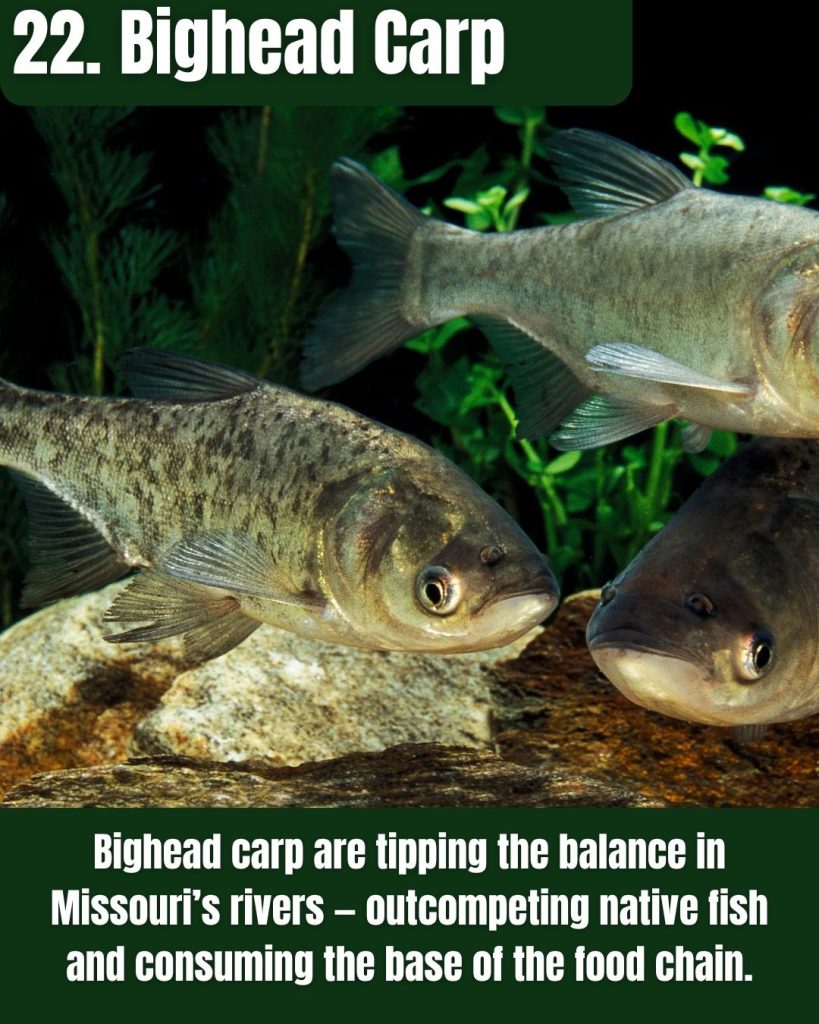
- Filter-feeding giants: Can grow over 100 pounds and consume enormous amounts of plankton, starving out native fish and mussels.
- River hogs: Compete directly with paddlefish, buffalo, and young sportfish in the Missouri and Mississippi Rivers.
- Hard to control: Spawn in large rivers and adapt quickly, making them tough to manage once established.
Weighing up to 80 pounds, bigheads gulp zooplankton by the bucketful, undercutting native fish recruitment.
Though less acrobatic than silver carp, they share the same runaway reproduction and food-web disruption.
Zebra Mussel (Dreissena polymorph)
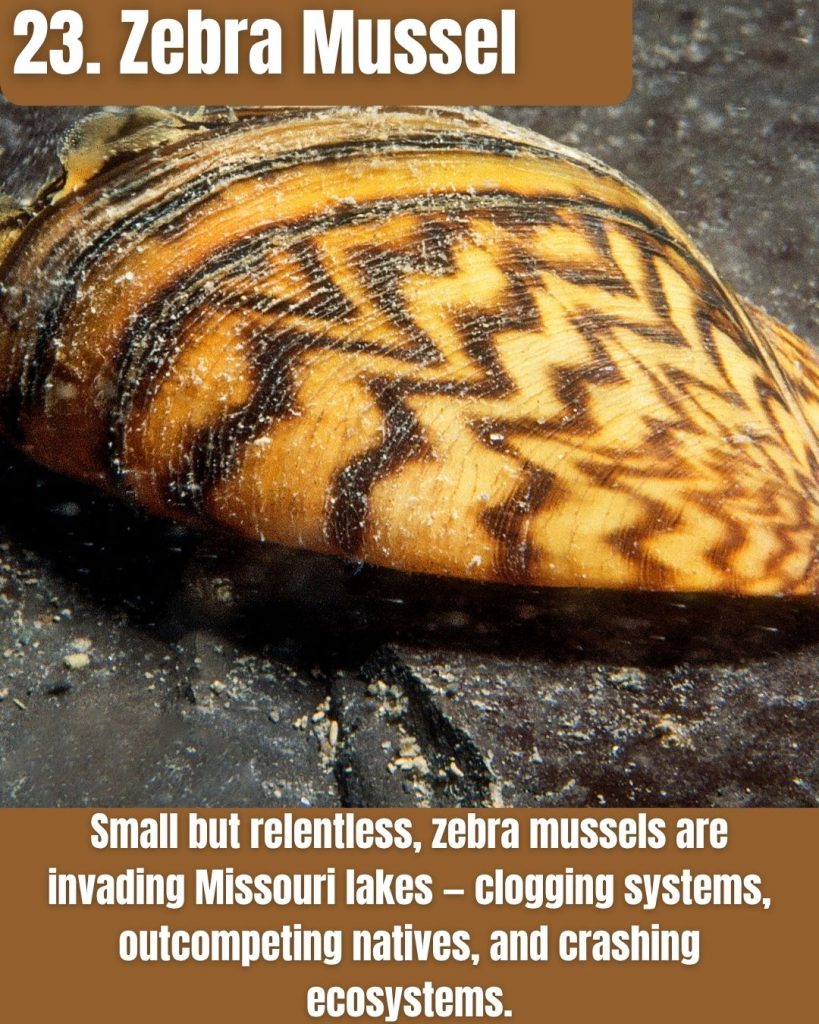
- Tiny takeover: Attach in dense clusters to boats, docks, and water systems, causing millions in damage annually.
- Reproductive machines: Just one female can release up to a million eggs per year, fueling explosive population growth.
- Food chain crashers: Filter out vital plankton, leaving native mussels and young fish without food.
Attached by the millions to pipes, zebra mussels clog water-intake systems and smother native mussels, while their voracious filtering strips plankton and can trigger toxic algal blooms.
“Clean, Drain, Dry” remains Missouri’s mantra for boaters.
Eurasian Watermilfoil (Myriophyllum spicatum)

- Aquatic tangle: Forms dense underwater mats that choke out native plants and hinder boating, swimming, and fishing.
- Easy spreader: Spreads from tiny fragments, a single stem piece can start a new infestation.
- Oxygen robber: Crowds out native vegetation, leading to reduced oxygen levels and poor habitat for fish.
This feathery aquatic plant spreads by stem fragments, forming underwater snarls that tangle props, degrade fish habitat, and choke swimming beaches.
Even a two-inch clipping can root elsewhere, so vigilant boat cleaning is essential.
Purple Loosestrife (Lythrum salicaria)
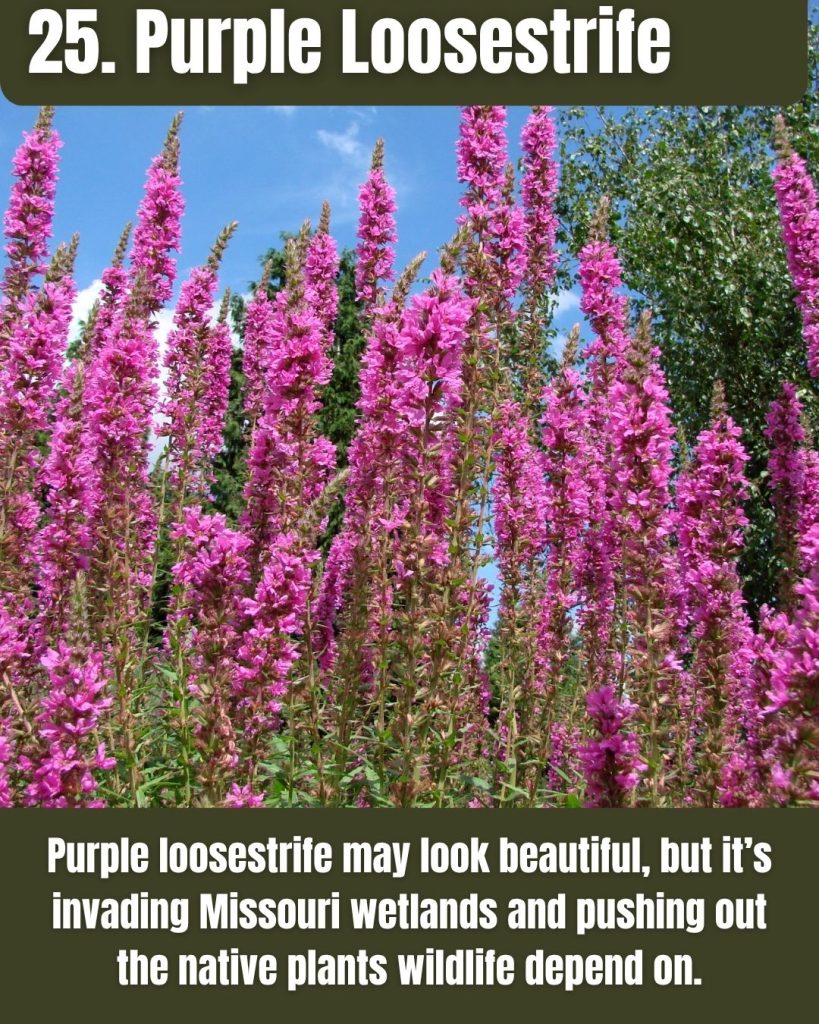
- Pretty but perilous: Its tall spikes of purple flowers hide a plant that chokes out native wetland species.
- Seed powerhouse: A single plant can produce over 2 million seeds per year, spreading rapidly along rivers and ditches.
- Habitat killer: Forms dense stands that reduce biodiversity and waterfowl habitat, replacing vital wetland plants.
Beautiful but destructive, purple loosestrife turns biodiverse marshes into monocultures, crowding out cattails and reducing food for ducks.
Each stalk drops millions of seeds, yet beetle biocontrol agents offer hope of keeping this wetland invader in check.